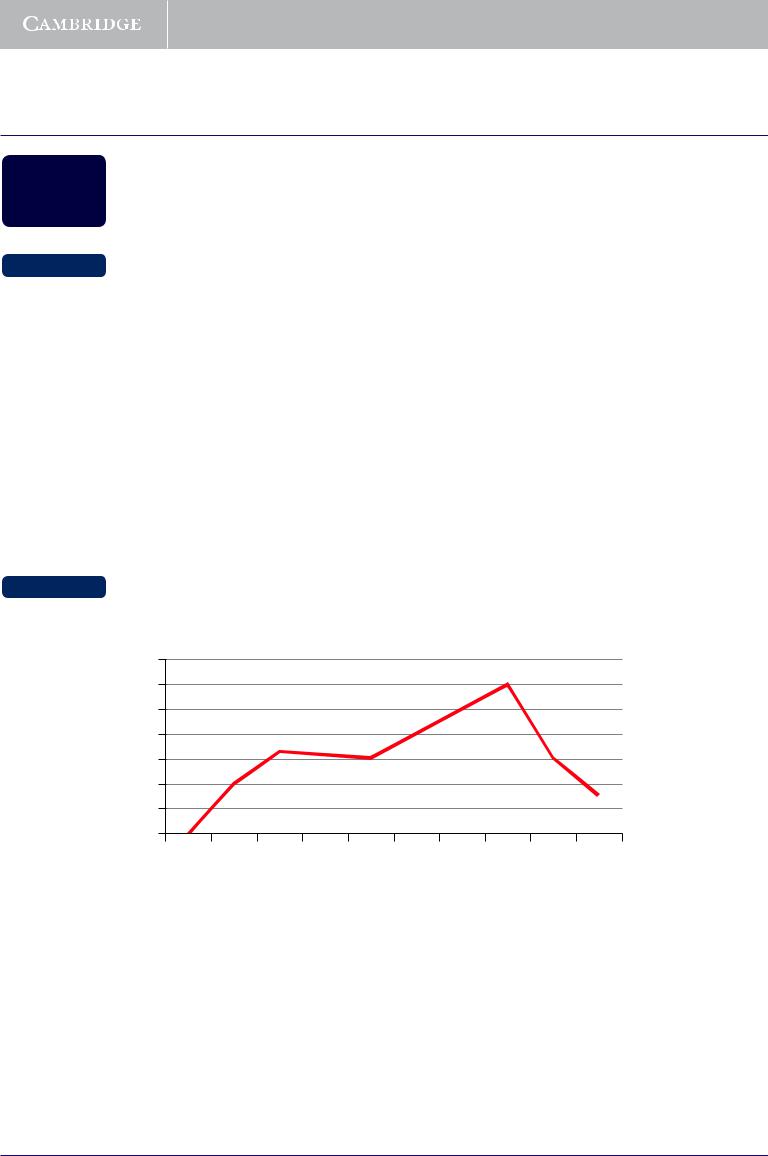
Professional - Marketing
.pdf
Cambridge University Press
978-0-521-70269-0 - Professional English in Use Marketing Cate Farrall and Marianne Lindsley
Excerpt
More information
6 The market environment
AThe micro environment
Learnmarketing.net provides information for marketing students. Its website says the following about the micro environment:
http://www.learnmarketing.net
The following factors have a direct impact on the company and its stakeholders: consumers, employees, shareholders and suppliers. The company has an infl uence over these factors.
consumers |
A company must understand consumer needs and meet them. |
|
|
competitors |
You must differentiate your brand from your competitors’. |
|
|
employees |
Employing the right people and keeping them motivated is essential. |
|
Training and development play a key role in the service sector. |
|
|
media |
Positive or adverse (negative) media attention can seriously affect an |
|
organization. Consumer programmes on TV and consumer magazines |
|
that people read have a powerful effect on the marketplace. |
|
|
shareholders |
It is important to satisfy shareholders’ needs without harming the |
|
brand in the long term. |
|
|
suppliers |
Changes in the price or quality of raw materials – for example wood, or |
|
metals – will affect the marketing mix. Good relations with suppliers will |
|
make business easier. |
|
|
BThe macro environment: STEP analysis
A STEP analysis (also known as a PEST analysis) looks at sociological, technological, economic and political factors in the market environment on a macro level – often looking at a particular country or region. The relationship between the company and these factors is indirect. This is a STEP analysis for an online supermarket in Britain.
SOCIOLOGICAL FACTORS
Dominant religions: Mainly Christian, with significant minorities in some regions. Special diets in some areas.
Leisure activities: Watching TV, cooking, socializing.
Gender roles: Now that younger men shop as much as women, we need to target both sexes equally. Birth rates: Birth rates are continuing to decline, with fewer babies born every year.
Average life expectancy: This is increasing so we should think about products for older customers. Attitudes to foreign products: Consumers like to experiment with foreign food and drink.
Opinions on environmental issues: We should use only recyclable packaging and hybrid-fuel delivery vans.
TECHNOLOGICAL FACTORS
Innovation and technological advances:
Production: New product lines and product types are continually coming onto the market. Offer: We now offer a new service – ordering by mobile phone.
Distribution: Online ordering has changed the way supermarkets operate. We no longer need actual shops. Communication with consumers: Broadband internet connections make it possible to include more product photos on our site. We could even think about adding video.
ECONOMIC FACTORS
The economic forecast is good:
Interest rates: stable at 5%
Unemployment rate: less than 9% of people are out work
GDP (Gross Domestic Product): growing steadily
POLITICAL FACTORS
Political stability: Very good. Consumers feel relaxed about the political situation and ready to use consumer credit.
New tax / business legislation: No changes to the law for our business sector in the near future. International trade agreements: We can import products from the EU without paying extra import duties.
18 |
Professional English in Use Marketing |
© Cambridge University Press |
www.cambridge.org |
|
|
|
|

Cambridge University Press
978-0-521-70269-0 - Professional English in Use Marketing Cate Farrall and Marianne Lindsley
Excerpt
More information
6.1Decide whether the following market environment characteristics are micro factors or macro factors. Look at A and B opposite to help you.
Micro Macro
1 High unemployment in a region reduces spending on leisure activities.
2 The internet has opened up new distribution and marketing channels.
3Good relations between a supplier and a company mean that goods are always delivered on time.
4Legislation in European countries is restricting the right to smoke in public places.
5 Positive reports in the national press about a brand.
6The staff for the telephone hotline of an internet bank are trained to be polite and friendly.
7During the FIFA World Cup, more snack food is consumed in front of the TV set.
6.2Complete the action plans (1–6) and then match them with the micro factors (a–f). Look at A opposite to help you. The first one has been done for you.
1 |
Convince shareholders that the best way to |
satisfy |
their needs in the long term is to |
|||
|
invest in research and development. |
|
|
|
|
|
2 |
Carry out market research to better |
|
needs and desires. |
|||
3 |
Prepare a press release for a |
magazine about the launch of a new product. |
||||
4 |
Build and maintain good |
by always paying on time. |
||||
5 |
Do a SWOT analysis to assess how to |
|
|
your brand from your competitors’. |
||
6 |
Implement a training and |
plan to motivate and keep good members. |
||||
a |
competitors |
c employees |
|
e |
shareholders |
|
b consumers |
d media |
|
f |
suppliers |
||
6.3Complete the STEP analysis of France. Look at B opposite to help you.
France is a member of the European Union and as such has trade (1) |
with |
|||
the other members. It has one of the worst unemployment (2) |
in Europe |
|||
and the government is keen to bring this down. |
|
|
||
France has one of the highest (3) |
rates in Europe (1.9 children per woman) |
|||
and a large proportion of French mothers go back to work, reflecting changes in |
||||
(4) |
roles. Men are almost as likely as women to do the shopping for the |
|||
family and take care of the children. |
|
|
||
The dominant (5) |
is Catholicism, but there is a large Muslim community. |
|||
The religious beliefs do not significantly affect the marketplace, except at Christmas and
Easter time when the demand for Christmas trees and chocolate increases dramatically.
Internet penetration is high: most households own a computer and have high speed internet access. This has opened up new channels of (6) and there are now several internet grocery stores.
Nearly all teenagers own a mobile phone and they are increasingly using SMS messages to keep in touch with their peers. Marketing campaigns are beginning to exploit this line of (7) by sending SMS messages to their audience.
Over to you 
Prepare a STEP analysis for the country or region you live in.
Professional English in Use Marketing |
19 |
© Cambridge University Press |
www.cambridge.org |
|
|
|
|

Cambridge University Press
978-0-521-70269-0 - Professional English in Use Marketing Cate Farrall and Marianne Lindsley
Excerpt
More information
7 Legal aspects of marketing
ALegal definitions
The World Intellectual Property Organization gives the following definitions:
Intellectual property refers to creations of the mind: inventions, literary and artistic works, and symbols, names, images and designs used in commerce. Intellectual property is divided into two categories:
1Industrial property includes patents, which give the exclusive right to make, use and sell an invention in a given geographical area; trademarks (words or symbols that differentiate a company); and industrial designs. A granted patent gives patent protection for 20 years in the UK. After that time you must renew the patent. In order to trademark, or register your trademark, you will need to complete a registration process.
2Copyright protects literary and artistic works. Copyright protected work includes novels, plays, films, musical works, artistic works such as drawings, photographs, and architectural designs. Copyright protected work is said to be subject to copyright.
Note: The copyright symbol: ©
The trademark symbol: ™
The registered trademark symbol: ®
BLegal problems
Legal problems may arise if another person has used copyright protected work without the copyright owner’s (or holder’s) permission. The UK Patent Office says:
‘Intellectual property (IP) crimes include counterfeiting and piracy. Counterfeiting is deliberate or wilful trademark infringement and piracy is wilful copyright infringement. Infringement means reproducing copyrighted work without permission from the IP owner.’
If a trademark or copyright holder believes that another person has made unauthorized use of a trademark or copyright, then this may lead to a lawsuit, where one company takes another to court to enforce the trademark or copyright. The infringer, the person who has broken the copyright, may have to pay damages or compensation to the trademark holder, normally financial.
Most company websites include a page called terms and conditions or copyright information. Visitors to the site must agree to the terms and conditions. The terms and conditions usually contain what a visitor may download or take from the web page and post or upload to the web page, and a disclaimer to say the company is not legally responsible for the misuse of its web pages.
CThe Consumer Protection Act
The Consumer Protection Act is a law in the UK that protects the consumer from faulty or defective products, or products that are not as safe as they are generally expected to be. Consumers are legally entitled to goods of a satisfactory quality. Producers, suppliers and importers are liable for – that is, responsible for – the products they sell. Death, personal injury – involving physical damage to a person – and damage to private property are covered under the act.
Enforcement of the act – that is, making sure the act is respected – is the job of the trading standards officer. Businesses need to monitor and control their produce to make sure they are fulfilling, or carrying out, all safety regulations.
A central part of the law is product liability, which means that any person who is injured or physically hurt by a defective product does not have to prove a manufacturer negligent
– that is, at fault – before suing, or taking the manufacturer to court.
20 |
Professional English in Use Marketing |
© Cambridge University Press |
www.cambridge.org |
|
|
|
|

Cambridge University Press
978-0-521-70269-0 - Professional English in Use Marketing Cate Farrall and Marianne Lindsley
Excerpt
More information
7.1Complete the copyright information from the WWF-UK web page. Look at A and B opposite to help you.
http://www.wwf.org.net
The Panda symbol
The WWF panda symbol is a (1)  trademark and is subject to
trademark and is subject to
(2)  .
.
It must not be used or reproduced without (3)  .
.
7.2Make sentences using one part from each column. Look at A and B opposite to help you.
1 |
Patent |
must read and agree to the terms |
renewed regularly. |
|
|
|
|
2 |
A granted |
protection gives a company the |
to a lawsuit. |
|
|
exclusive |
|
|
|
|
|
3 |
Wilful trademark |
copyright cannot be used without |
right to market a product. |
|
|
|
|
4 |
Visitors to the website |
patent must be |
permission. |
|
|
|
|
5 |
Material that is |
infringement may lead |
and conditions. |
|
subject to |
|
|
|
|
|
|
7.3Complete the newspaper report and then match the problems (a–c) with the offered solutions (i–iii). Look at C opposite to help you.
FIGHT FOR YOUR RIGHTS WHEN A DEAL GOES WRONG
By Ruki Sayid
Stores do their best to part us from our cash, but they are not always as friendly if a (1) is defective. We have teamed up with consumer watchdog Which? to offer some help.
is defective. We have teamed up with consumer watchdog Which? to offer some help.
aThe iron I bought was faulty and I was given a replacement, but that also stopped working after a week. The shop has refused to exchange it, saying the second iron was a gift. Is this correct?
bMy parents bought us a washing machine as a present but it exploded when we were out. The smoke and fi re damage is extensive. Who is responsible for this?
cI have written many letters to a local supermarket after having found bits of glass in their fresh fruit. I still don’t have a satisfactory response.
Which? answers:
iAs you did not buy the machine yourself, you have no contract with the shop. But you can claim against the manufacturer under the Consumer Protection Act 1987 for
(2) to your house and any
to your house and any
(3) injury.Your parents, however, can claim for the machine from the retailer.
injury.Your parents, however, can claim for the machine from the retailer.
iiTry contacting the trading (4) officer. He / she is responsible for
officer. He / she is responsible for
(5) of the Consumer Protection Act.
of the Consumer Protection Act.
iiiNo, you are legally (6) to goods of a (7)
to goods of a (7) quality.
quality.
Over to you 
Think about intellectual property owned by your business, school or family. What is it, and how is it protected?
Professional English in Use Marketing |
21 |
© Cambridge University Press |
www.cambridge.org |
|
|
|
|

Cambridge University Press
978-0-521-70269-0 - Professional English in Use Marketing Cate Farrall and Marianne Lindsley
Excerpt
More information
8 Research 1
ATypes of research
Marketing research is the process of gathering information about a market, analysing it and interpreting it. Although the term market research is often used to mean the same thing, technically it only refers to research into a specific market. Consumer research – used to discover behaviour patterns (how people act) and customer needs (see Unit 20) – is an essential element of marketing research. Motivation research investigates the psychological reasons why individuals buy specific types of merchandise, or why they respond to specific advertising appeals.
There are two main methods of consumer research:
desk (desktop) research or secondary research: an analysis of the information you can find easily without leaving your desk. Examples include the internet, books, newspapers, magazines, and government statistics.
field research or primary research: involves talking to people and finding out what they think about a market, a product, a business sector, etc. It is usually carried out by market research institutes.
Consumer research can be either qualitative or quantitative. In qualitative research, small group discussions or in-depth interviews with consumers are used to understand a problem better. Quantitative research involves collecting, or gathering, large samples of data (for example, on how many people use different products), followed by statistical analysis – examining, or analysing, the data. Quantitative research is often used to investigate the findings from qualitative research.
Note: The singular noun is (an) analysis, and the plural is analyses. Data is used as both an uncountable noun and as a plural noun. The data is interesting. The data show interesting trends. The activity of analysing data can also be referred to as mining data.
BResearch methodology
A student has made notes while reading a book on marketing research techniques.
Focus groups: small groups from the target group plus one moderator to mediate or run the session. The moderator prepares questions for the session.
Package test: used to test ideas for new packaging; could be in a focus group.
Taste test: used to test what consumers think about new fl avours.
Home test: consumers try the products at home, in a real situation.
A self-administered questionnaire is completed (or fi lled in) by the respondent, and an interviewer-administered questionnaire is fi lled in on behalf of the respondent by an interviewer.
Telephone surveys are carried out by telephoning the respondent and asking questions.
A mail survey is mailed to the respondent, who completes it and posts it back.
Online surveys are administered on the internet.
Mystery shopping: a person poses as a consumer and checks the level of service and hygiene in a restaurant, hotel or shop.
Omnibus surveys: a market research institute carries out (or conducts) research for several companies at the same time. A long survey is given to respondents; some institutes have a panel of existing respondents who are accustomed to answering the surveys.
22 |
Professional English in Use Marketing |
© Cambridge University Press |
www.cambridge.org |
|
|
|
|

Cambridge University Press
978-0-521-70269-0 - Professional English in Use Marketing Cate Farrall and Marianne Lindsley
Excerpt
More information
8.1Match the types of research in the box with the research problems below. Look at A and B opposite to help you.
desktop + secondary |
qualitative + field |
motivation + primary |
quantitative + primary |
|
|
1The R&D department want to know why people buy mobile phones so that they can develop a new model that answers all the major needs.
2The design team want to know how consumers feel about the new layout of the company website before they finalize and launch the new homepage.
3A manager wants to have financial data on her company, her competitors and the economy in general.
4The marketing team want to have a lot of data on their consumers: age, shopping habits, email address, etc.
8.2Complete the sentences. Look at B opposite to help you.
1 |
A lot of marketing research institutes carry out |
|
surveys. They ring people at |
||
|
home and ask them questions. |
|
|
|
|
2 |
A |
is a small discussion group, led by a |
who asks |
||
|
questions to get detailed and qualitative information. |
|
|
||
3 |
A marketing research institute may prepare a lengthy |
|
survey which it posts to |
||
|
consumers at their homes. These |
surveys have questions from several different |
|||
|
companies on them. |
|
|
|
|
4 |
Some questionnaires are completed by the |
|
(self-administered questionnaires) |
||
|
and some are completed by the interviewer ( |
|
- |
questionnaires). |
|
5 |
|
surveys are usually carried out in-store to assess the levels of |
|||
|
service quality and cleanliness. |
|
|
|
|
6 |
A |
test is designed to find out what consumers think about packaging, and a |
|||
|
|
test is to find out what they think about the flavour of a product. |
|||
8.3Cross out the incorrect sentence in each group. Look at A and B opposite to help you.
1 |
|
4 |
|
a |
We carried out the research last week. |
a |
It can take a long time to mine data. |
b |
We conducted the research last week. |
b |
It can take a long time to carry out data. |
c |
We collected the research last week. |
c |
It can take a long time to analyse data. |
2 |
|
5 |
|
a |
The respondents completed a questionnaire. |
a |
We are filling in three focus groups. |
b |
The respondents analysed a questionnaire. |
b |
We are mediating three focus groups. |
c |
The respondents filled in a questionnaire. |
c |
We are running three focus groups. |
3 |
|
|
|
a |
We must run the data quickly. |
|
|
b |
We must collect the data quickly. |
|
|
c |
We must gather the data quickly. |
|
|
Over to you 
Think about how you would carry out market research for a completely new product (for example, a light bulb that works without electricity). What kind of research would you conduct during the development phase of the product, and what kind just before the product launch?
Professional English in Use Marketing |
23 |
© Cambridge University Press |
www.cambridge.org |
|
|
|
|

Cambridge University Press
978-0-521-70269-0 - Professional English in Use Marketing Cate Farrall and Marianne Lindsley
Excerpt
More information
9 Research 2
ADescribing survey results
There are number of different ways to talk about survey results.
|
highlight(s) |
the need to … |
||
Recent research |
that the respondents feel strongly about … |
|||
indicate(s) |
||||
The survey |
that the trend is upward ↑ / downward ↓ … |
|||
reveal(s) |
||||
The latest figures |
satisfaction with the service – people are happy with it. |
|||
show(s) |
||||
The key findings |
dissatisfaction with the product range – people don’t like it. |
|||
suggest(s) |
||||
|
that our consumers would prefer to see … |
|||
|
|
|||
|
|
|
|
|
A mere 5% |
|
|
said taste was very important. |
|
Ten percent |
of the |
|
claimed taste influenced their purchase. |
|
Over half |
|
cited taste as an important part of the decision to buy. |
||
respondents |
|
|||
Almost 60% |
|
rated the new taste better than the old one. |
||
|
|
|||
Nearly two thirds |
|
|
thought the taste was much better. |
|
|
|
|
|
|
Note: The key findings are the most important findings.
We use mere when we want to emphasize that the amount is not large, or not important. For more information on talking about figures see Appendix III on page 110.
BUnderstanding trends and changes
Maggie Potters has just completed a survey of consumer ratings for a brand of mobile phones and is making a presentation to the phone manufacturers.
Approval ratings
70
60
50
40
30
20
10
0 |
2 |
3 |
4 |
5 |
6 |
7 |
8 |
9 |
10 |
1 |
Years
‘The graph shows consumer ratings of the product over a ten-year period. You can see that after the launch of the product the ratings rose to 33%. The trend was stable until the arrival of a major competitor in the market. This led to a slight fall in approval ratings. The relaunch of the brand invigorated the product and so you can see ratings rising to 60%, the ratings doubled. However, reports in the national press have had a negative effect on the brand image and approval ratings have plummeted. Compared to the same period last year, a significantly higher number of consumers have a low opinion of the product and the brand image. The percentage of dissatisfied respondents has trebled. Although this seems to be very negative, your initial guesstimates, your predictions before you had the figures, were much worse.’
24 |
Professional English in Use Marketing |
© Cambridge University Press |
www.cambridge.org |
|
|
|
|

Cambridge University Press
978-0-521-70269-0 - Professional English in Use Marketing Cate Farrall and Marianne Lindsley
Excerpt
More information
9.1Read the extract from a survey of blog readers by Blogads, and correct any mistakes in the sentences below. Look at A opposite and Appendix III on page 110 to help you.
http://www.blogads.com
Thanks to the 17,159 blog readers who responded to our survey!
This survey shows that blog readers are older and more affl uent than most optimistic guesstimates: 61% of blog readers responding to the survey are over 30, and 75% earn more than $45,000 a year.
Moreover, blog readers are even more cyber-active than we’d hoped: 54% of their news consumption is online. 21% are themselves bloggers and 46% describe themselves as opinion makers. And, in the last six months, 50% have spent more than $50 online on books, and 47% have spent more than $500 online for plane tickets.
Blog readers are big media consumers: 21% subscribe to the New Yorker magazine, 15% to the Economist, 15% to Newsweek and 14% to the Atlantic Monthly. They are also far more male – 79%!
– than we expected, versus 56% of NYTimes.com’s readers.
1 Three quarters of the respondents earn more than $45,000 a year. 2 Almost half of their news consumption is online.
3 A mere 79% of respondents are male.
4 One out of two respondents has spent more than $50 online on books.
5 The survey suggests that all bloggers are over 30.
9.2Complete the description of the graph. Look at B opposite to help you.
ratings |
600 |
|
|
|
|
500 |
|
|
|
|
|
400 |
|
|
|
|
|
Approval |
300 |
|
|
|
|
200 |
|
|
|
|
|
100 |
|
|
|
|
|
0 |
|
|
|
|
|
|
2001 |
2002 |
2003 |
2004 |
|
|
2000 |
||||
|
|
|
Years |
|
|
The graph represents intentions to buy (1)  a five-year period. The new insurance policy was launched in 2000. After the launch, the intention to buy (2)
a five-year period. The new insurance policy was launched in 2000. After the launch, the intention to buy (2)  sharply. A (3)
sharply. A (3)  higher number of consumers expressed a strong interest in the policy. This upward trend was (4)
higher number of consumers expressed a strong interest in the policy. This upward trend was (4)  for a two-year (5)
for a two-year (5)  . In 2003 the company started to suffer from a damaged reputation, following allegations of illegal trading on the stock market. This is reflected in the number of intentions to buy, which (6)
. In 2003 the company started to suffer from a damaged reputation, following allegations of illegal trading on the stock market. This is reflected in the number of intentions to buy, which (6)  just before the company name was changed and the policy dropped.
just before the company name was changed and the policy dropped.
Over to you 
Look at this extract from the blog reader survey mentioned in 9.1 above. Describe the results of the survey as if to your team or manager.
Have you clicked on a blog ad? |
Response |
Response |
||
|
|
|
Percent |
Total |
Yes |
|
|
66.7% |
10161 |
|
|
|||
No |
|
|
22.4% |
3412 |
|
|
|||
Can’t recall |
|
|
10.9% |
1661 |
|
|
|||
|
|
Total Respondents |
15234 |
|
|
|
(Skipped this question) |
1925 |
|
|
|
|
|
|
Professional English in Use Marketing |
25 |
© Cambridge University Press |
www.cambridge.org |
|
|
|
|

Cambridge University Press
978-0-521-70269-0 - Professional English in Use Marketing Cate Farrall and Marianne Lindsley
Excerpt
More information
10 New product development 1
Idea |
Idea |
Concept |
Concept |
Marketing |
Business |
generation |
screening |
development |
testing |
strategy |
analysis |
AIdea generation
Idea generation is the systematic search for new product ideas. It is the first step in the new product development (NPD) process. NPD is essential for companies to stay competitive. Ideas for product innovation can come from many sources – for example, internal brainstorming (see Unit 12), distributors, or increasingly from customers. Many companies are adopting a customer-driven or customer-centric marketing approach, focused on identifying customer demands (what customers are asking for) and understanding consumer needs (what customers require to solve a particular problem). Market research techniques (see Unit 8) are used to identify gaps in the market.
Throughout the NPD process, marketers work closely with research and development (R&D) to create original products or to modify or improve existing products. New recipes (for example, Vanilla Coke) and limited or special editions (for example, Christmas tea) are examples of product improvements and product modifications. The product innovation may target a mass market or a specific niche market – products for left-handed people, for example.
BIdea screening
Launching new products is a risky business, so new product ideas are screened to select, or spot, potentially successful product ideas. A company has to assess which ideas are viable
(will survive in a competitive marketplace), technically feasible (the company has the skills and resources to produce them), and profitable (will make money). The company also considers overall demand – how much they can expect to sell.
CConcept development and testing
An attractive idea is developed into several different product concepts. Concept testing measures customer response to a new product – what customers think of it – and gives an indication of the level of consumer acceptance – that is, how readily consumers will use the product. The objective is to successfully introduce the new product onto the market or penetrate the market, and to minimize the research and development costs.
DMarketing strategy and business analysis
The marketing strategy (see Unit 4) describes how to penetrate the market. You must decide which route to market is best for your product or service. You can produce it yourself, you can sell the idea, or you can license the product to another company to produce and market.
Before moving on to the product development phase (see Unit 11), businesses need to assess the financial attractiveness of the new product idea. Companies estimate the sales volume (how much they will be able to sell), the selling price (what consumers will pay for the product or service) and revenue expectations (how much income the product will generate).
BrE: licence (noun), license (verb); AmE: license (noun), license (verb)
26 |
Professional English in Use Marketing |
© Cambridge University Press |
www.cambridge.org |
|
|
|
|

Cambridge University Press
978-0-521-70269-0 - Professional English in Use Marketing Cate Farrall and Marianne Lindsley
Excerpt
More information
10.1Find words and phrases in A, B, C and D opposite to make word combinations with the words below.
product |
market |
10.2Complete the sentences about new product ideas. Look at A and B opposite to help you.
1A  edition pack could be good to celebrate the fiftieth anniversary of the product.
edition pack could be good to celebrate the fiftieth anniversary of the product.
2We must be responsive and  -driven. Have we identified the customer needs and demands?
-driven. Have we identified the customer needs and demands?
3 |
A |
recipe would work well for a short time, but does it really show added value? |
|
4 |
I don’t think that would be |
feasible. We just couldn’t produce it. |
|
5 Is that really going to work? I mean, is it really  in our marketplace?
in our marketplace?
10.3Complete the text. Look at A, B, C and D opposite to help you.
Here’s how I exploited a (1)  in the market
in the market
Gecko Headgear Ltd is a designer and manufacturer of marine safety helmets, founded in 1993 by Jeff Sacrée. Jeff explains how he spotted a gap in the niche water sports (2)  .
.
‘As a surfer, I could see a potentially (3)  product, a helmet that was both lightweight and heat-retaining.’
product, a helmet that was both lightweight and heat-retaining.’
‘However, surfing is a relatively small market and I began wondering if I could (4)  other markets with my helmet design.’
other markets with my helmet design.’
Jeff adds, ‘A good relationship with the bank is crucial when you’re trying to bring an innovative product to market. In our case the product
(5)  phase took three years – far longer than we initially expected.’ Jeff decided the best (6)
phase took three years – far longer than we initially expected.’ Jeff decided the best (6)  to market was to grow his business and produce the helmets himself.
to market was to grow his business and produce the helmets himself.
Over to you 
Imagine you are talking to Steve Jobs at Apple about his next i-product. Think of three questions to ask him about the product. Think of three more questions you could use to screen his ideas.
Professional English in Use Marketing |
27 |
© Cambridge University Press |
www.cambridge.org |
|
|
|
|
